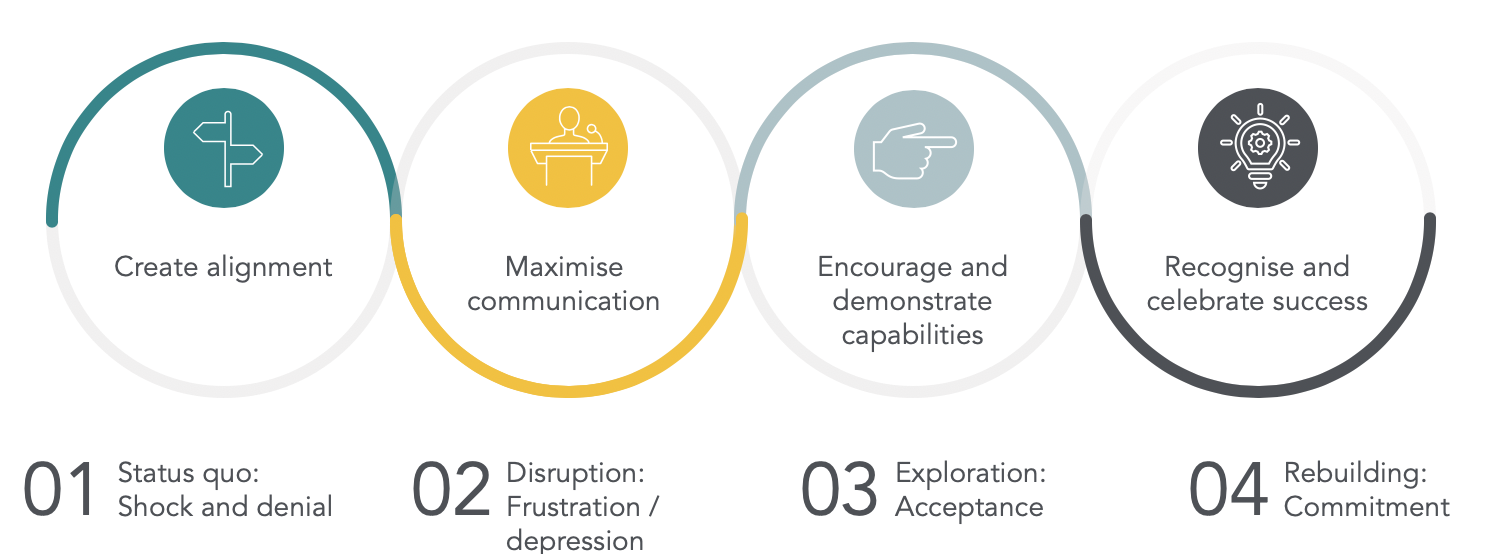Benjamin Franklin said nothing is certain but death and taxes, but if he were alive today, then he would probably include “change” on his list. At home and work, our lives are being transformed primarily through technology; the Internet of Things, new phone upgrades, smart electric meters, hackers, phishing, the cloud, artificial intelligence…
Is it any wonder that with all this change, people are fatigued? Is it a surprise that employees don’t understand the business need for change, they worry about their job security or just feel overwhelmed? Technology is inarguably driving such a rapid pace of change and such potentially transformative outcomes in all industries, that it is essential employees understand the benefits to the business and to them personally, and are engaged with the change journey.
Any change programme must lead employees through the change curve and explain why the change is taking place, create alignment across the business and make the most of the crucial part that employees play in any transformation. In other words, communication is vital. It can make the difference between success the first time, or a costly and underwhelming outcome that undermines the credibility of your leadership, your team and the change programme.
Time and again, in our work with clients, we see four stages in any change or transformation programme: status quo, disruption, exploration and rebuilding. They correspond with common emotions: shock and denial, frustration and depression, acceptance and finally, with commitment, the change becomes normalised. Expert communications can help to smooth the proverbial rollercoaster ride.
Every organisation has its status quo, a legacy system that everyone understands, but that badly needs upgrading. There are undoubtedly potential opportunities for many organisations to embrace the digital revolution or fully integrate disparate parts of the business. Early communication and honesty are imperative at this stage to bring employees on board from the start, calm unnecessary fears and, most importantly explain why the change needs to happen. Employees need to catch up with the leaders, who have been preparing for this change for much longer and are much further along the curve than they are, potentially creating a disconnect that will only grow the longer it goes unaddressed. This stage is also an excellent point to identify those who are excited about the change or early adopters to ask them to be project or change ambassadors in the next stages.
The disruption stage marks the point that everyone knows change is coming, the implementation plan is in progress and employees could feel vulnerable, frustrated and potentially distant from the new direction of the business. Throughout this phase, it is more important than ever to have a clear message and defined next steps. Maintain regular communications, even if it’s just to confirm when there will be an update. Start a training programme and have two-way feedback channels. People must feel a part of the change.
Once the software or structure is in place or the new way of working is in its final stages, there is the opportunity to embed the new normal into the workforce. The communications plan must help employees accept the change through demonstrating the benefits that were just theoretical before. Utilising ambassadors to model behaviours and provide peer-to-peer support, sharing successes, as well as addressing any feedback, should also form part of any comms plan.
Finally, the change becomes business as usual and accepted. There will be some on-going support needed, including any upgrades if it is an IT system, and continuous improvement, as well as onboarding new employees into the company’s culture. For some time afterwards, when planning new projects, it is essential to bear in mind that everyone just went through a significant change and it could affect employees’ appetite for more.
Of course, the scenario described here is the ideal. Things can, and do, go wrong from a technical or business perspective. However, with proper communication, and working with an experienced change communication specialist from the start, it is easier to engage employees and keep them engaged, smoothing the way to a successful endpoint and the next stage in the business’ evolution.
For more information on how change communication experts can help your business, contact Emma Sinden.



